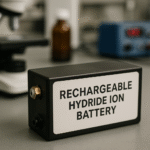By Harshit | October 17, 2025 | London | 12:00 PM GMT
A New Dawn for Solar Power
For years, scientists and clean energy advocates have hailed perovskite solar cells as the next great leap in renewable energy — capable of pushing solar efficiency far beyond the limits of traditional silicon panels. Now, with companies like Oxford PV leading the charge, that vision is inching closer to reality.
Inside a high-tech laboratory on the outskirts of Oxford, UK, researchers at Oxford PV are testing samples of tandem perovskite solar cells, which merge perovskite materials with conventional silicon to extract more power from the same amount of sunlight. These hybrid cells have achieved record-breaking conversion efficiencies, and early prototypes are being shipped to solar farms around the world for testing.
But the key question remains: can they withstand real-world conditions?
How Perovskites Work — and Why They Matter
Perovskite is not a single material, but a class of compounds with a specific crystal structure, first discovered in 1839. Modern perovskite solar cells are synthetically made using elements such as tin, lead, bromine, and chlorine — all inexpensive and widely available.
The innovation lies in combining these perovskite materials with silicon to form tandem solar cells. While standard silicon panels can convert roughly 21–23% of sunlight into energy, tandem perovskite cells theoretically push that limit above 47%.
According to Oxford PV’s internal analysis, these panels could lower the cost of electricity by around 10% compared with standard silicon modules — a potentially transformative leap for solar energy economics.
Promise and Pitfalls
Perovskite’s strengths are clear: higher efficiency, flexibility, and lower manufacturing costs. These materials can even be sprayed onto thin surfaces like windows or vehicles, expanding solar applications beyond rooftops and farms.
However, critics point to real concerns. Perovskites are highly sensitive to heat and moisture, degrading faster than silicon. Many also contain trace amounts of lead, raising environmental and safety questions.
“Manufacturers of silicon modules can guarantee 30-year lifetimes because they’ve got 30 years of field data,” says Joseph Berry of the U.S. National Renewable Energy Laboratory. “For perovskites, knowing that the module we’re making today will last 30 years is still a hard material science question.”
Oxford PV and its peers, including U.S.-based Caelux and Swift Solar, are working to overcome these hurdles through better encapsulation techniques and new material formulations.
The Race for Commercialization
Oxford PV’s recent achievements are impressive. In 2024, the company broke the record for the world’s most efficient residential solar module at 26.9% efficiency. Now, it’s producing tandem modules in a German factory and shipping pilot batches — enough to power about 14 average U.S. homes — to a commercial solar site in the United States.
Meanwhile, other players are racing ahead.
- Trina Solar in China reported a world-record 31.1% efficiency for a tandem cell in April 2025.
- Longi, another Chinese giant, achieved 33.9% efficiency for a single perovskite cell.
- Swift Solar, a U.S. startup from MIT and Stanford, is deploying panels on communication towers through a deal with American Tower Corporation.
The competition underscores a broader trend: perovskite tandem technology is no longer confined to the lab — it’s entering industrial-scale testing and early deployment phases.
Durability vs. Efficiency
While perovskite tandems promise unmatched power output, long-term durability remains a sticking point. At Oxford PV’s research center, cells undergo “accelerated ageing tests” — exposure to extreme humidity, temperature swings, and UV radiation — to simulate years of weathering within weeks.
The company’s sustainability head, Laura Miranda, emphasizes that this process is vital: “These tests give us an idea of how cells might degrade in real conditions without waiting five, ten, or fifteen years.”
Even if perovskites degrade faster, experts argue that higher energy production could offset shorter lifespans. “The real value here,” says Caelux CEO Scott Graybeal, “is how much total energy you produce over a project’s lifetime — not just how long the panel lasts.”
The Global Impact
Solar power already generates nearly 7% of the world’s electricity and is growing faster than any other energy source. As the second-cheapest form of new electricity after onshore wind, solar is projected to dominate global energy markets in the 2030s — and perovskite technology could accelerate that shift.
If tandem perovskite panels can deliver on their promise of higher efficiency and lower costs, they could drastically reduce the land and materials needed for global decarbonization. However, their success hinges on one factor: proving that they can endure the elements as well as they perform under lab lights.
Conclusion
For now, the perovskite solar revolution is both a technological marvel and a scientific gamble. The material’s performance is stunning — but its long-term stability remains untested.
Still, companies like Oxford PV, Trina, and Caelux are betting big on a future where perovskite-silicon tandems become the global standard. If they succeed, the world could soon see the dawn of a new solar age — one where sunlight powers more of our lives than ever before.







